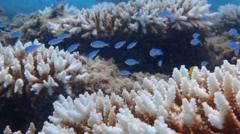World-renowned coral reefs along the coast of Western Australia are experiencing the worst bleaching crisis on record due to what researchers describe as the state's "longest, largest, and most intense" marine heatwave. From August of the previous year through May, elevated water temperatures subjected the reefs to significant heat stress, causing many corals to expel the symbiotic algae critical for their survival and color—a phenomenon known as bleaching.
The extent of the damage is extensive, covering approximately 1,500 kilometers (932 miles) and reaching regions that had previously remained untouched by climate change impacts. This grim situation comes at a time when coral reefs globally have been grappling with a prolonged two-year bleaching event, fueled by unprecedented ocean temperatures.
Typically, just eight weeks of sustained heat stress is lethal for corals. Preliminary assessments by Australia’s marine science agency indicate that various reefs in Western Australia likely experienced heat stress levels that could kill between 15% and 30% of their coral populations. "What we’re observing in terms of the duration and severity of heat stress—and its reach across multiple regions—is unprecedented for most reefs in the state," stated James Gilmour from the Australian Institute of Marine Science (AIMS).
Their latest findings highlight the current 2024-2025 season as the most severe for coral bleaching on record throughout both northwestern and central WA reefs. Areas that once offered hope due to their infrequent bleaching—such as the Rowley Shoals, north Kimberley, and Ningaloo—have not been spared this time. "Finally, climate heating has caught up with these reefs," Gilmour remarked.
Ningaloo Reef, a designated World Heritage site, mirrors the plight of Australia’s Great Barrier Reef on the eastern coast, which has faced significant coral deterioration in recent years. In fact, just last week, a report indicated that the Great Barrier Reef experienced its largest coral decline in nearly four decades.
Amidst this ecological crisis, Federal Environment Minister Murray Watt emphasized the urgent necessity for Australia and the global community to intensify efforts against climate change, advocating for achieving net-zero emissions. The current patterns of coral bleaching events are becoming increasingly severe, frequent, and widespread as a direct consequence of climate change. Dr. Gilmour pointed out that corals require 10 to 15 years to recover from such stress, leaving them little chance to rebound as climate-induced threats intensify.
The United Nations has previously warned that even if global temperature rise is capped at 1.5C above pre-industrial levels, a staggering 70 to 90% of the world's tropical coral reefs risk extinction.

















